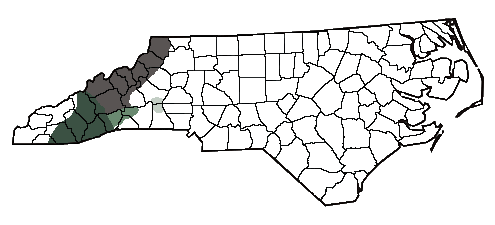-gmc-6-5-2010-Biscuit_Rock, NC.jpg)
Grey-cheeked Salamander Complex
Photo by Grant Connette
Species in Complex: Blue Ridge grey-cheeked salamander (Plethodon amplus), South Mountain grey-cheeked salamander (Plethodon meridianus), southern grey-cheeked salamander (Plethodon metcalfi), northern grey-cheeked salamander (Plethodon montanus)
Description: The Jordan’s salamander, red-legged salamanders, and grey-cheeked salamanders were formerly considered a single species. This single species has since been divided into a complex of seven closely related species. There are four species of grey-cheeked salamanders, all of which are dark grey with lighter grey cheek patches. There are no white or red markings anywhere on the body. The four species of grey-cheeked salamanders appear essentially identical and are best identified by location. Southern grey-cheeked salamanders and northern grey-cheeked salamanders have the widest ranges and are essentially separated by the French Broad River. Blue Ridge grey-cheeked salamanders are found in a small area to the east of the southern grey-cheeked salamander. South Mountain grey-cheeked salamanders occur only in the South Mountains and are found in just two counties in North Carolina.
Habitat/Range: Grey-cheeked salamanders are generally found only in forests in mountainous terrain. This highly-terrestrial species is often found under rocks, logs, or debris on the forest floor. These salamanders are most easily detected at night, especially under wet conditions, as individuals wander the forest floor in search of food. In some parts of their range, grey-cheeked salamanders may also be found in rock crevices.
Diet: Grey-cheeked salamanders consume primarily small forest floor invertebrates.
Reproduction: Nests of grey-cheeked salamanders have never been found. It is likely that they lay their eggs in underground cavities during late spring or early summer. Females of most closely-related species will guard their eggs until hatching and it is thought that grey-cheeked salamander females probably do the same. Grey-cheeked salamander hatchlings do not go through an aquatic larval stage. Instead, when young salamanders emerge from their eggs they look like miniature adults.
Miscellaneous: When threatened, grey-cheeked salamanders release noxious, sticky skin secretions which are used to deter predators. Although grey-cheeked salamanders are often the most commonly found species across much of their range, the Blue Ridge grey-cheeked salamander and the South Mountain Grey-cheeked salamander are at risk due to their extremely small distributions. Both species lack protected status in the state of North Carolina, the only state in which they are found.

Refer to the description section of the text for explanations of the species' ranges.
 S Tilley.jpg)
-gmc-6-21-2008-Mt Rogers, VA.jpg)
-gmc-6-14-2008-Mt Mitchell, NC.jpg)
Photo by S Tilley
Northern grey-cheeked salamander.
Photo
by Grant Connette
Photo by Grant Connette
-gmc-6-29-2010-Grant_Mountain, NC.jpg)
. Rutherford Co. NC. KC1.jpg)
Blue Ridge grey-cheeked salamander.
Photo by Grant Connette
Blue Ridge grey-cheeked salamander.
Photo by Kristen Cecala
